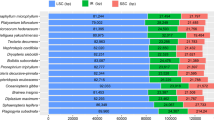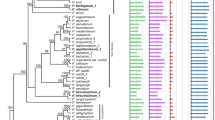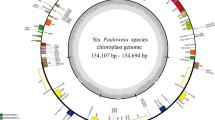Abstract
The typical chloroplast genome consists of two inverted repeat (IR) and two single-copy (SC) regions. Each region has its own pattern of molecular evolution. Many studies have shown that the IR region has a low substitution rate. The plastid rps12 gene encodes ribosomal protein small subunit 12, which is composed of 5′-rps12 (exon 1) and 3′-rps12 (exon 2–3); 3′-rps12 is near the IR region and enters or leaves the IR region as it expands and contracts, enabling study of the variation in its substitution rate. We analyzed the evolutionary rate and adaptive evolution of the rps12 genes of 118 ferns and 2 lycophytes in a phylogenetic context using the maximum likelihood method. We found that the substitution rate of exon 2–3 was significantly lower in the IR region than in the LSC (1–11 times higher in the LSC), and also lower than that of exon 1 in the LSC region (1.9–6.7 times higher for exon 1). In addition, there was more GC content at the third codon position, and the rps12 gene encoded 123 amino acids, with 107 negative selection sites and 4 positive selection sites. These results prove that the substitution rate decreases after the sequence fragments enter the IR region and demonstrate the highly conserved nature of the rps12 gene.






Similar content being viewed by others
Availability of data and material
Data are available as Electronic Supplementary Material.
References
Bromham L, Penny D (2003) The modern molecular clock. Nat Rev Genet 4:216–224. https://doi.org/10.1038/nrg1020
Hollingsworth PM, Graham SW, Little DP (2011) Choosing and using a plant DNA barcode. PLoS One 6:e19254. https://doi.org/10.1371/journal.pone.0019254
Kearse M, Moir R, Wilson A et al (2012) Geneious Basic: an integrated and extendable desktop software platform for the organization and analysis of sequence data. Bioinformatics 28:1647–1649. https://doi.org/10.1093/bioinformatics/bts199
Khakhlova O, Bock R (2006) Elimination of deleterious mutations in plastid genomes by gene conversion. Pl J 46:85–94. https://doi.org/10.1111/j.1365-313X.2006.02673.x
Kumar S, Stecher G, Tamura K (2016) MEGA7: molecular evolutionary genetics analysis version 7.0 for bigger datasets. Molec Biol Evol 33:1870–1874. https://doi.org/10.1093/molbev/msw054
Li FW, Kuo LY, Pryer KM, Rothfels CJ (2016) Genes translocated into the plastid inverted repeat show decelerated substitution rates and elevated GC content. Genome Biol Evol 8:2452–2458. https://doi.org/10.1093/gbe/evw167
Lin CP, Wu CS, Huang YY, Chaw SM (2012) The complete chloroplast genome of Ginkgo biloba reveals the mechanism of inverted repeat contraction. Genome Biol Evol 4:374–381. https://doi.org/10.1093/gbe/evs021
Lowe TM, Eddy SR (1997) tRNAscan-SE: a program for improved detection of transfer RNA genes in genomic sequence. Nucl Acids Res 25:955–964. https://doi.org/10.1093/nar/25.5.955
Maier RM, Neckermann K, Igloi GL et al (1995) Complete sequence of the maize chloroplast genome: gene content, hotspots of divergence and fine tuning of genetic information by transcript editing. J Molec Biol 251:614–628. https://doi.org/10.1006/jmbi.1995.0460
Norihiro Z, Keita T, Kazuo S et al (1987) Trans splicing in vivo: joining of transcripts from the ‘divided’ gene for ribosomal protein S12 in the chloroplasts. Febs J 210:153–156. https://doi.org/10.1016/0014-5793(87)81326-1
Perry AS, Wolfe KH (2002) Nucleotide substitution rates in legume chloroplast DNA depend on the presence of the inverted repeat. J Molec Evol 55:501–508. https://doi.org/10.1007/s00239-002-2333-y
Pond SL, Frost SD, Muse SV (2005) HyPhy: Hypothesis testing using phylogenies. Bioinformatics 21:676–679. https://doi.org/10.1093/bioinformatics/bti079
PPG I The Pteridophyte Phylogeny group, (2016) A community-derived classification for extant lycophytes and ferns. J Syst Evol 54:563–603. https://doi.org/10.1111/jse.12229
Stamatakis A (2014) RaxML version 8: a tool for phylogenetic analysis and post-analysis of large phylogeies. Bioinformatics 30:1312–1313. https://doi.org/10.1093/bioinformatics/btu033
Wolfe KH, Li WH, Sharp PM (1987) Rates of nucleotide substitution vary greatly among plant mitochondrial, chloroplast, and nuclear DNAs. Proc Natl Acad Sci USA 84:9054–9058. https://doi.org/10.1073/pnas.84.24.9054
Wu CS, Chaw SM (2015) Evolutionary stasis in Cycad plastomes and the first case of plastome GC-biased gene conversion. Genome Biol Evol 7:2000–2009. https://doi.org/10.1093/gbe/evv125
Wyman SK, Jansen RK, Boore JL (2004) Automatic annotation of organellar genomes with DOGMA. Bioinformatics 20:3252–3255. https://doi.org/10.1093/bioinformatics/bth352
Yang Z (2007) PAML 4: phylogenetic analysis by maximum likelihood. Molec Biol Evol 24:1586–1591. https://doi.org/10.1093/molbev/msm088
Zerbino DR, Birney E (2008) Velvet: algorithms for de novo short read assembly using de Bruijn graphs. Genome Res 18:821–829. https://doi.org/10.1101/gr.074492.107
Zhu AD, Guo WH, Gupta SS et al (2016) Evolutionary dynamics of the plastid inverted repeat: the effects of expansion, contraction, and loss on substitution rates. New Phytol 209:1747–1756. https://doi.org/10.1111/nph.13743
Acknowledgements
The authors wish to thank Ziying Liang, and Xiuqin Ma for technical assistance and sharing opinions, ShanShan Liu for the sample. This work was funded by the National Natural Science Foundation of China (31670200, 31770587, 31872670 and 32071781).
Author information
Authors and Affiliations
Corresponding authors
Ethics declarations
Conflict of interest
The authors declare that they have no conflict of interest.
Additional information
Handling Editor: Yunpeng Zhao.
Publisher's Note
Springer Nature remains neutral with regard to jurisdictional claims in published maps and institutional affiliations.
Information on Electronic Supplementary Material
Below is the link to the electronic supplementary material.
Information on electronic supplementary material
Information on electronic supplementary material
Online Resource 1. Plastomes sampled in this study.
Online Resource 2. Alignment of the complete chloroplast genome sequences used in this study.
Online Resource 3. Alignment of the tandem data set of rbcL and matK sequences used in this study.
Online Resource 4. Alignment of the rps12-CDS sequences used in this study.
Online Resource 5. Alignment of the exon1 sequences used in this study.
Online Resource 6. Alignment of the exon2-3 sequences used in this study.
Online Resource 7. Maximum likelihood (ML) tree constructed based on the complete chloroplast genome.
Online Resource 8. Maximum likelihood (ML) tree constructed based on concatenated data sets of rbcL and matK.
Online Resource 9. Distribution of exon 1 and exon 2-3 values for each species in IR-109.
Rights and permissions
About this article
Cite this article
Ping, J., Li, A., Feng, P. et al. The highly conserved rps12 gene in ferns provides strong evidence for decreased substitution rates in the inverted repeat region. Plant Syst Evol 307, 26 (2021). https://doi.org/10.1007/s00606-021-01750-7
Received:
Accepted:
Published:
DOI: https://doi.org/10.1007/s00606-021-01750-7




